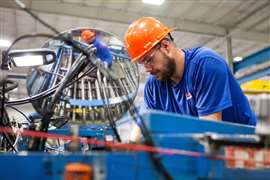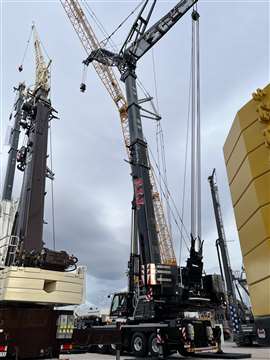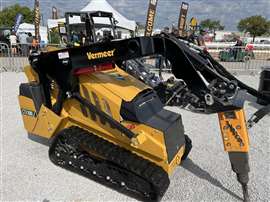What can construction equipment OEMs expect in 2024?
05 December 2023
A look at three concerns for equipment manufacturers going into the New Year
With year-end rapidly approaching, many construction equipment companies are busy laying out plans for next year. But trying to determine the best path forward may not be easy. Internal and external challenges can create a lot of uncertainty, even if they’re being felt across the board.
Here are three concerns for manufacturers going into the New Year — and insights that can help address them.
Addressing internal workforce shortages
Internally, the biggest challenge for manufacturers is no longer the supply chain. It’s finding and retaining labor. The manufacturing sector is particularly vulnerable to the labor pool shortage (and the resulting increased inflationary pressure).
 The biggest challenge for manufacturers is finding and retaining labor. (Photo: Jonathan from Pixabay)
The biggest challenge for manufacturers is finding and retaining labor. (Photo: Jonathan from Pixabay)
There are approximately 1.5 jobs for every job seeker in the U.S. This has resulted in a 4.5% average wage growth over the last five months. This adds to production costs. The problem is expected to continue, as no workers are available to replace the boomers who will retire in the next few years.
The labor force participation rate has also declined. During COVID-19, many employees aged 55 and older left the workforce. They are not coming back. A long-term concern is the birth rate, which has been historically low in recent years. As a result, attracting talent will be a very long-term problem.
While technology can help address the labor shortage, successful companies will need to develop plans for attracting and retaining employees. This will require innovative thinking coupled with strategic messaging. Some recent creative approaches include four-day work weeks and 36-hour weekend shifts.
Dealing with market volatility
The construction market outlook continues to be bolstered by the Infrastructure and Jobs Act, the CHIPS and Science Act, and the Inflation Reduction Act. These government investments are pumping hundreds of billions of dollars into infrastructure, energy and utilities, industrial and manufacturing sectors — with the industrial building sector currently booming.
Despite this investment, the overall U.S. construction industry has remained very weak in real terms. It has contracted around 3% according to data presented by GlobalData at the AEM Equipment Market Outlook Webinar. This is mostly due to a drop in residential construction, which is by far the single largest sector in the construction market. Interest rates put pressure on financing new mortgages, impacting the number of industry projects.
 2024 may see a shift in demand to larger equipment as the market pivots toward infrastructure and industrial projects. (Photo: KHL Staff)
2024 may see a shift in demand to larger equipment as the market pivots toward infrastructure and industrial projects. (Photo: KHL Staff)
Contractors involved in infrastructure, energy and utilities, and industrial and manufacturing sectors should do well in 2024 and beyond. However, it’s important to realize money pumped into the pipeline does not immediately reach the contractor. There is a significant amount of money in the pipeline that will continue to work its way through for the next several years.
Just think. Before the first earth is moved, there’s project initiation, design and the bidding process. Much of the funding through the Infrastructure and Jobs Act, the CHIPS and Science Act, and the Inflation Reduction Act is still in the project initiation and design phase. That’s promising for future work in the pipeline.
But what does all this mean for construction machinery sales? We may see a shift in demand for certain types of equipment as the market pivots toward infrastructure and industrial projects. These projects often favor the use of larger equipment.
Even though there is work in the pipeline, contractors have been subjected to a lot of volatility in recent years. COVID-19, supply chain issues, fuel and material price fluctuations, rising inflation, and record interest rates have many contractors wondering: What’s next? There is potential for a surge in crude oil prices due to the conflict in the Middle East. This would drive up material costs and lead to even higher inflation.
Interest rates are currently sitting at a 22-year high. Barring a surge in crude oil prices, several economists have predicted that these rates will slightly ease. Until interest rates come off their highs, it may be more difficult to convince contractors to make large capital investments. Contractors may also be holding off on purchases until they see some stability return to the markets.
This could bode well for the equipment rental market. Elevated interest rates and uncertainty mean many contractors may increasingly turn to equipment rental as a solution. The rental market in North America has grown consistently over the years as contractors look for ways to reduce costs and increase flexibility. Rental provides access to the optimal machine for a given task and contractors only pay for the use. This eliminates the overhead ownership cost and the temptation to make an existing machine in the fleet fit the application.
The current uncertainty could accelerate the well-established trend toward rental. Today, more than 50% of equipment on a construction jobsite is rented rather than owned.
Navigating external labor concerns
Construction contractors face the same labor shortage as all the skilled trades. Even if the work is there, contractors may be resistant to purchase additional equipment when they can’t find operators to keep it productive. It is not necessarily a shortage of work holding the industry back, but a decades-long employee shortage limiting how much work contractors can complete.
 Equipment suppliers who can demonstrate how their solutions can allow contractors to do more with fewer employees could have an advantage. (Photo: KHL Staff)
Equipment suppliers who can demonstrate how their solutions can allow contractors to do more with fewer employees could have an advantage. (Photo: KHL Staff)
Equipment suppliers who can demonstrate how their solutions can allow the contractors to do more with fewer employees could have an advantage. Similar to the factors driving the shortage of manufacturing labor, there is a rapid deterioration in the pool of skilled laborers and experienced operators. As retirement takes its toll, there is not enough talent emerging from the pipeline.
Technologies that hold promise either reduce the crew size needed to complete a task or they allow lower-skilled operators to perform the desired task. Simplified controls, semi-autonomous operation and remote control are all gaining traction in the construction equipment market to address labor concerns.
With every challenge, an opportunity emerges. Looking to 2024 and beyond, the construction equipment market offers opportunities for equipment manufacturers that can develop plans to overcome the current internal and external challenges.
Curt Bennink is Senior PR Editor at Lessing-Flynn, an independently owned advertising agency based in Des Moines, IA. Bennink has been a staple in the construction media industry for 25 years, serving as an editor for various publications before joining Lessing-Flynn in March 2022.
STAY CONNECTED



Receive the information you need when you need it through our world-leading magazines, newsletters and daily briefings.
CONNECT WITH THE TEAM







